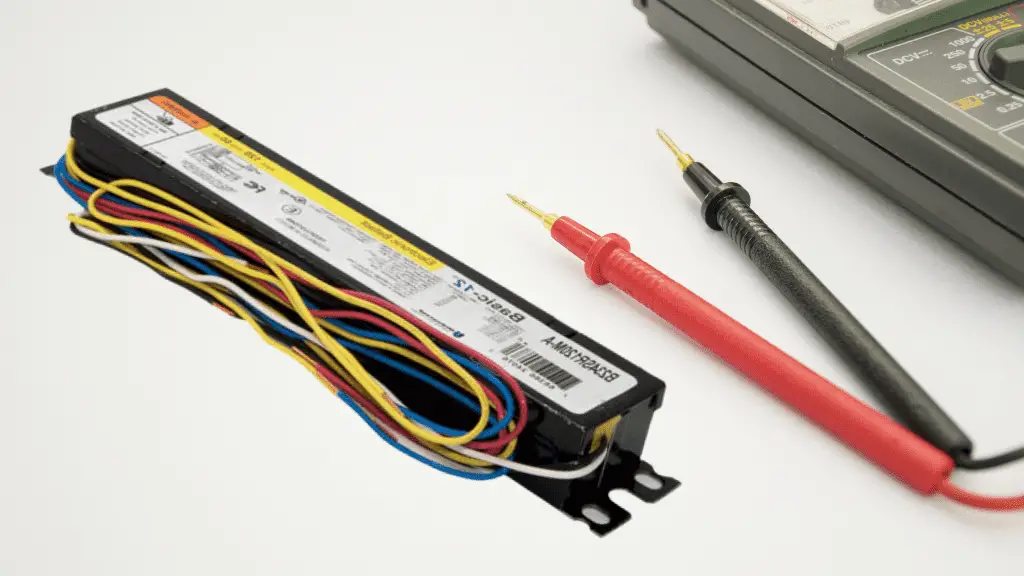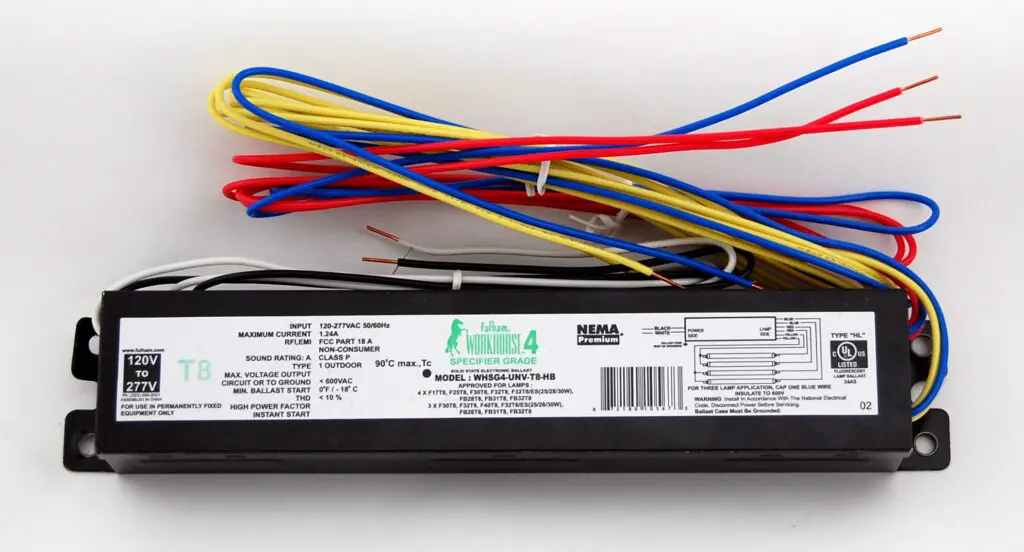Last Updated on August 2, 2023 By Emma W. Thomas
According to the Certified Ballast Manufacturers Association, an average fluorescent ballast lasts about 75000 hours or, in other terms, 12-15 years of regular usage. The optimum and economic life is usually 15 years.
How Long Does Fluorescent Ballast Last?

When discussing the longevity and durability of lighting systems, fluorescent ballasts typically stand out due to their exceptional lifespan. These essential components in the fluorescent lighting system directly influence the functional lifespan of the light fixture.
1. General Lifespan of Fluorescent Ballast
Typically, fluorescent ballasts last around 50,000 hours, translating to approximately six years considering a usage scenario of 24 hours a day. If the usage is reduced to half (12 hours a day), the lifespan may extend up to around 12 years.
2. Factors Determining The Lifespan
The lifespan of a fluorescent ballast is subject to a variety of factors such as environmental conditions, usage, maintenance, and quality of the product. Longer lifespan can be expected if the usage scenario involves optimal conditions.
3. Quality of the Fluorescent Ballast
High-quality ballasts tend to have a longer lifespan compared to their low-quality counterparts. Therefore, the initial investment in a superior product often results in extended longevity and lower maintenance costs.
4. Maintenance and Care
Regular maintenance and care can significantly improve the lifespan of fluorescent ballast. Ensuring that the bulbs are promptly replaced when they burn out, maintaining appropriate voltage, and keeping the fixtures clean contributes to maintaining the proper functioning and extending the lifespan.
5. Environmental Conditions
Operating conditions greatly affect the lifespan of fluorescent ballast. Efficient functioning can be altered due to extreme temperatures (either too high or too low), excessive humidity, or corrosive environments. For instance, in hot or humid conditions, the overall lifespan of ballast may decrease due to adverse effects on the circuitry.
6. Switching Cycles
A significant factor influencing the lifespan of a fluorescent ballast is the number of switching cycles (i.e., on/off times). The more frequently a ballast is switched off and on, the shorter its lifespan tends to be.
How Does One Know That The Fluorescent Ballast Requires Replacement?
Sometimes, one hears some loud buzzing sounds when one flicks the lights. Other times it may be lighting intervals that become inconsistent. The chances are that the bulbs are not to blame but the fluorescent ballasts which have reached their load limit. Overloaded fluorescent ballasts leave the bulbs with nothing to regulate the light, and sometimes they may overload and fry.
Catching a faulty fluorescent ballast can save one a lot of hassle associated with buying new replacement bulbs and fixtures. Replacing bulbs and fixtures that have not lived to their limit adds to one’s miscellaneous expenses, and some brand bulbs and tubes may be expensive. The following are a few signs to check out that indicate whether the fluorescent ballast may need replacement or not:
Identifying Whether One’s Light Requires A Fluorescent Ballast
One should determine whether their lighting requires a fluorescent ballast since not all lights require them. It helps one decide whether the ballast is the problem or the entire fixtures and sometimes just the bulb and lamps. Incandescent, LED, and halogen bulbs do not require a ballast. Other bulbs and lamps have an integrated ballast inside them which cannot be separated.
Most fluorescent bulbs, for instance, have internal fluorescent ballasts. For such bulbs with integrated ballasts, they are replaced just like the regular bulbs when they become faulty or die. One cannot tear up the bulb to replace its internal mechanisms.
The most common lights with separate fluorescent ballasts are the lone T12 and T8 fluorescent lights mostly used in business buildings with one commonly shared ballast. You can easily replace the ballast without swapping the light strips. Therefore, only bulbs and lamps with separate fluorescent ballasts will require ballast replacement.
Look Out For Warning Signs Of A Faulty Ballast.
After identifying a problem with one’s lighting system and whether they require a ballast, the next step is looking out for faulty ballast signs. If just a single bulb is going out or misbehaving, one should replace the bulbs. If the problem is spread across the entire lighting section, the following tests should be carried out.
1. One should check for a buzzing sound. It is a strange sound that comes from the tubes, like a humming sound. Such sound is one sign that the ballast is faulty as it is overloaded, making it difficult to maintain the current flow. The buzzing sound results from voltage regulation problems, which makes it audible.
2. The bulbs or tubes dimming or flickering is another sign to look out for. Bulbs tend to be slow in reaching their full brightness. The problem could be the ballast’s inability to regulate current.
3. Sometimes the bulbs may not turn on, which may result from a faulty ballast that might have burned them all out. The ballast could damage the entire fixture if the problem is not identified and rectified on time.
4. In some cases, bulbs might fail to shine in the same hue and brightness in an abnormal way such that there is variance in their color. Chances are that the fluorescent ballast might be surging high and sporadic voltage to the bulbs resulting in unequal currents flowing to the bulbs.
These are the standard and most visible signs of a faulty ballast. If such signs are present, then it is time to move to the next checking point.
Check The Fluorescent Ballast.
A faulty ballast that is slowly huffing is very obvious. One should ensure to turn off the fixtures circuit breaker in the electric panel when checking the ballast. Doing so prevents any chances of burning the entire fixture while checking the fluorescent ballast. The first thing is removing the cover of the bulbs and then examining the ballast for the following;
1. The first thing to check is whether the ballast casing is swollen. A swollen ballast is identified by looking at the plastic condition. If it is bulging out, then the ballast is damaged probably from energy overload, which damages the plastic box.
2. If the plastic case is in the right condition, it is time to crack in and check the ballast’s interior condition. One opens up the case and looks for any burn marks. If present on the device or its wires, one should consider replacing it. In most cases of burn marks of wires and the case, the bulbs are likely to be damaged and need replacement.
3. One should check if there are any moisture traces. If present, water was the most probable source of damage to the ballast. When moisture is present in a fluorescent ballast, it leads to condensation, which causes corrosion on its interior parts.
4. The other sign to look out for is oil leakage. For the older magnetic coil ballast, oil leakage is a malfunction. One should clean up the area and replace the fluorescent ballast in such a case. It mostly happens in the older magnetic fluorescent ballasts.
What Causes Fluorescent Ballast Failure?
People start thinking of what might cause flickering in their bulbs, buzzing, delayed turning on, reduced light output, and inconsistent lighting levels. Fluorescent ballast may fail prematurely. Such failures are mostly caused by the surrounding environment, such as heat and moisture, which are the ballasts’ greatest enemies. All fluorescent ballasts come with their specified operating temperature range. When the temperature is too high or too low, the ballast can burn and sometimes fail to start the lamps and bulbs.
When moisture gets its way into an electronic ballast, it may lead to condensation, especially when combined with heat. Such an environment eventually leads to corrosion of internal parts of the ballast. Some people opt for removing the case and cleaning the corroded part but returning the case is complicated. To avoid such situations, one should consider replacing the ballast. To prevent corrosion from moisture congestion in the ballast, one should ensure the ballast is UL rated for moist and humid locations and have the ability to handle both high and low temperatures. In other cases, the mismatch of bulbs and the fluorescent ballast may cause the fixture’s burn. Some bulbs require specific fixtures and ballast, as some may carry more current than the bulb can hold.
What Are The Dos And Don’ts When Replacing Fluorescent Ballasts?

The following are essential things to consider when replacing fluorescent ballasts to prevent further damage:
1. One should ensure that the replacement ballast has the same ballast factors as the previous ones.
2. One should avoid replacing defective ballasts with magnetic fluorescent ballasts.
3. Ensure that enclosed fluorescent ballasts are protected from harsh weather, especially if installed outside.
4. All ballasts and associated fixtures should be properly grounded. One should also consider using high-power-factor fluorescent ballasts.
5. One should be sure to use class “A” ballasts in places where noise levels are considered.
6. Fluorescent ballasts made without PCBs must be handled appropriately and disposed of as they contain carcinogens, which may be hazardous.
7. One should keep heat and moisture from the fluorescent ballasts as they are their greatest enemies. The reason is that, when combined, they cause corrosion to the interior parts of the ballast.
How Much Does It Cost To Replace A Fluorescent Ballast?
Fluorescent ballast replacement requires care since a single mistake could burn up the entire fixture. For instance, some bulbs are designed to use specific ballast, and mismatching them may cause premature burning of the bulb or the ballast itself. Thus, one should check labels on fixtures when considering a replacement and the bulbs.
A standard replacement ballast costs about 10$-25$, highly dependent on the brand and its capacity. Including the labor cost involving the replacements, it totals around 75-150 dollars considering it will take about 5 minutes to work on each fixture. In the case of ceiling flash mount, one could consider buying new fixtures to replace them personally. In this way, one will avoid electrician charges which can be very high. Additionally, new fixtures usually come with new bulbs making them cheaper than the replacement ballasts.
Conclusion
Fluorescent ballasts have a long shelf life of 12-15 years when in regular use. They may even last longer if used economically by turning off lights when not used. Another way to increase their life is by avoiding turning them on and off unnecessarily. There are electronic ballasts and magnetic ballasts. Their main difference is their life cycle, with the electronic ballast lasting up to twice long as the magnetic ballasts. Another effective method of protecting the fluorescent ballasts is by avoiding any traces of moisture and heat around them as it leads to corrosion of its interior parts.
References:
https://www.fs.usda.gov/t-d/pubs/htmlpubs/htm01712310/index.htm
https://www.galvinpower.org/how-long-does-a-ballast-last/
Emma is a graduate of Domestic Science or Family and Consumer Sciences (Home Economics) from the University of Wisconsin. She has 7 years of experience Working with the strategic section of BestBuy and now writing full-time for Homeeon.
From Managing the Home, Interiors, Cleaning, and Exteriors to Gardening and everything about Making A Home Liveable – is her passion and this Homeeon is the result of this.
Emma loves decorating her home with the best stuff found online. She cares about quality over anything and writes reviews about them here in Homeeon. Get in touch with her over Pinterest.
Keep reading her blogs.

